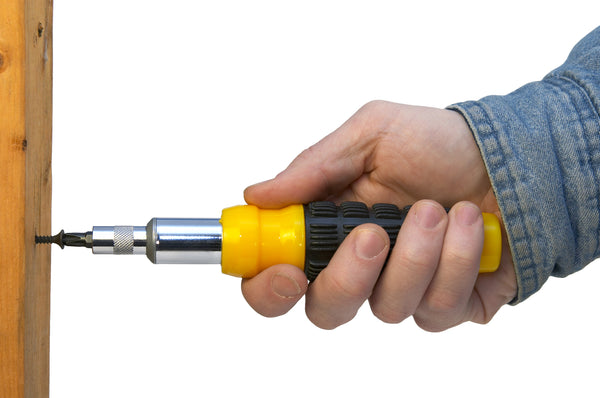All You Need To Know About Ratchet Screwdrivers

Jump to:
If you have ever used a traditional screwdriver, you will know that having to constantly reposition the screwdriver can be time-consuming, tiring, and difficult to do in small spaces. It is also necessary to use multiple screwdrivers when handling various tasks. What is more, traditional screwdrivers can slip or “cam out”, particularly when a large amount of torque needs to be provided. A potential solution to all of these problems is the ratchet screwdriver.
In this article, we shall look at what a ratchet screwdriver is, how it works, the situations in which it can be used, and a step-by-step guide for how to use it. We will also look at some examples of ratchet screwdrivers you might like to purchase.
What Is A Ratchet Screwdriver?
A ratchet screwdriver typically consists of four main parts.
Firstly, there is the handle that is normally ergonomically designed for comfort and featuring a non-slip material for better control.
There is also the ratchet mechanism, or shank, which is the key component. This basically allows you to turn the screwdriver in one direction, and freely move in the opposite direction again, without moving the screw. This means that you can carry out tasks such as tightening or loosening the screw without needing to reposition the screwdriver on the screw. The ratchet mechanism can be set to any of the three positions of tightening, loosening, and locked (this equates to being fixed for manual use).
There are also the bits and the bit holder. The bits are the interchangeable tips that fit into the bit holder. These come in a variety of types to match differently shaped screw heads, such as Phillips, flathead, and Torx varieties. These bits sit in a bit holder, which usually includes some mechanism for securing the bits, such as a magnet or locking mechanism.
How Does A Ratchet Screwdriver Work?

When set to the forward position (for tightening), the handle turns the screw in a clockwise direction. Once it has been turned to its limit, the handle is rotated back counterclockwise and the ratcheting mechanism disengages the drive. This means that you can move the handle back to the original position without moving the screw. The result is that you can keep tightening (or loosening) the screw without the need to reposition the tool after each turn.
We can now see how this helps resolve the issues with traditional screwdrivers discussed in the introduction, namely that using them can be time-consuming, fatiguing, difficult to use in small spaces, and a different screwdriver is often required for each task.
Using a ratchet screwdriver saves time as you do not need to reposition the tool after each turn, and as the user does not need to repeatedly turn the screwdriver, this reduces fatigue. As the area in which the screwdriver needs to be turned is also reduced, this enables it to be used in small spaces, and it is versatile enough to be used with multiple screw types, simply by changing the bit.
When Would You Use A Ratchet Screwdriver?

You would typically use a ratchet screwdriver in any situation where it is necessary to use a substantial amount of torque, and there may be limited space to work.
For example, when fixing electronics or gadgets, you can use the smaller bits available with a ratchet screwdriver when repairing or assembling electronic devices, such as computers, smartphones, and the like, and with the extra control it offers, it is possible to manage these sensitive components without damaging them.
When making home improvements, a ratchet screwdriver allows for precise and speedy screw driving, making D.I.Y tasks, such as installing light fixtures or curtain rails simpler and faster.
When assembling furniture, you can avoid the hand fatigue from repetitive screwing, and speed up the assembly process when tightening screws in desks, chairs, shelves and like.
When fixing plumbing equipment, such as brackets, clamps, and other fittings, the ratcheting mechanism enables you to navigate restricted spaces where it is not feasible to fully rotate a screwdriver.
Step By Step Guide To Using A Ratchet Screwdriver?

In this section, we shall provide step-by-step instructions for using a ratchet screwdriver. As always, beyond the actual steps for using the tool, there is a preparation process that will save you time and help prevent mistakes later.
In this case, it is very important that you understand your tool and its capabilities well before starting the process, so take time reading the instructions to make sure you have a firm grasp of the basics. It will also save you time later if you collect as many different bit shapes and sizes for your screwdriver as possible. This will mean that you will be ready to tackle almost any job on the fly.
So, are you sitting comfortably? Then, let’s begin.
- First, choose the right bit size and bit type for the job at hand, and insert the bit into the bit holder. If this does not fit snugly, you may have the wrong type of bit for that screwdriver.
- Now, it is time to set the direction on the ratchet screwdriver. Normally, there will be a direction switch on the racket screwdriver, and you will generally have the option to set it clockwise (for tightening), counterclockwise (for loosening), or locked (manual). If you take the last option, you are basically losing all of the benefits of having a ratchet screwdriver and it will behave just like a normal screwdriver, so in this guide, we will just look at cases where you are using the ratchet mechanism to tighten or loosen.
- After you have set it to clockwise, or counterclockwise, insert the bit into the head of the screw, making sure that the bit is aligned correctly and fits securely onto the screw head. If it is the wrong size, trying to tighten or loosen the screw may cause stripping where the shape of the screwhead is damaged and it will become impossible to handle. This is a particular problem when trying to loosen a screw.
- Once you have confirmed that the bit fits firmly into the head of the screw, hold the handle of the screwdriver firmly, and start turning the handle in the desired direction. The ratchet mechanism will click, indicating that you can reposition the handle, without moving the screw.
- Make short back and forward movements with your wrist. By doing this, you can keep turning the screw without lifting the tool.
- Once the screw has reached the requisite tightness, stop turning the handle and remove the bit from the screw head. You can then remove the bit from the screwdriver by pulling the collar back toward the handle, which will release the bit.
Options For Purchasing A Ratchet Screwdriver

So, after reading this article you are convinced that a ratchet screwdriver is a must-have item for your D.I.Y toolkit, but how do you go about getting one? Ratchet screwdrivers are available at a variety of tool stores, but you can also purchase them directly from the Daitool website.
Deen is a Japanese tool brand that prides itself on developing high-quality versatile tools, and their ratchet screwdrivers are no exception. These include, for example, the Deen Fast Action Twist Handle Reversible Ratchet Wrench & Screwdriver. This screwdriver allows for fast action tightening and loosening by simply twisting the handle, making it perfect when working in cramped or confined spaces. With adapters for both 1/4" and 3/8" sockets, it is able to function as both a ratchet wrench and a screwdriver.
Another offering from Deen is the Pistol Grip Ratchet Screwdriver & Socket Driver Set. This versatile, space-saving tool features seven interchangeable bits and a ratcheting handle with three settings (fixed, clockwise, and counterclockwise). It also converts from a straight to a pistol-grip handle for greater torque and includes a hidden bit holder for added convenience, functioning as a screwdriver, ratchet wrench, and t-handle. It can also be used with the Deen 1/4" Square Male Socket Shank For Ratcheting Screwdriver to hold sockets for undoing nuts and bolts.
Embracing The Versatility Of Ratchet Screwdrivers
As discussed in this article, ratchet screwdrivers offer numerous advantages over traditional screwdrivers including efficiency of operation, ease of use, and versatility, to name just a few of their merits. The ability they have to be able to operate in tight spaces without constantly needing to reposition the tool make them suited for a variety of tasks, including plumbing work, electronics repair, home improvements, and woodwork, and this positions them as an invaluable member of your D.I.Y toolkit.
Their functionality is further enhanced by having interchangeable bits, enabling you to tackle a wide variety of screw types with a single tool. Whether you are a professional in the field or just a D.I.Y enthusiast, investing in a high-quality ratchet screwdriver will streamline your work, reduce fatigue, and enable you to carry out complex tasks in a simpler, more efficient way.
Do you use a ratchet screwdriver at home? For what jobs do you find it particularly useful? Let us know in the comments.

0 comments